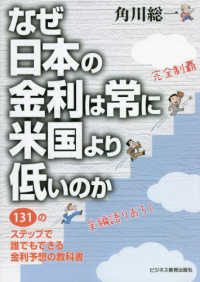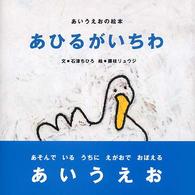- ホーム
- > 洋書
- > 英文書
- > Philosophy
Full Description
Articles 56-59 of Henry of Ghent's Summa is devoted to the trinitarian properties. Henry was the most important Christian theological thinker in the last quarter of the 13th century and his works were influential not only in his lifetime, but also in the following century and into the Renaissance.
Henry's Quaestiones ordinariae (Summa), articles 56-59 deal with the trinitarian properties and relations, topics of Henry's lectures at the university in Paris. In these articles, dated around 1286, Henry treats generation, a property unique to the Father, and being generated, a property unique to the Son.
The university in Paris distributed articles 56-59 by means of two successive exemplars divided into peciae. Manuscripts copied from each have survived and the text of the critical edition has been established based upon the reconstructed texts of these two exemplars.
Contents
Foreword
Critical study
The Editions and Manuscripts
§ 1. The Editions
§ 2. The Manuscripts
The Text Examined Exteriorly: Historical and Codicological Elements Used For the Establishment of the Text
§ 1. The Authorship and Date of the Summa, art. 56-59§ 2. The Summa, art. 56-59: Distributed by Means of Two Successive Exemplars by the University in Paris
A. The First Parisian University Exemplar
B. The Second Parisian University Exemplar
The Text Examined Interiorly: The Relationships Among the Manuscripts, Established by a General Test Collation
§ 1. The Common Accidents
A. The Groups of Manuscripts Characterized by the Number of
Common Accidents
B. The Groups of Manuscripts Characterized Individually
1. Manuscript B" (Biblioteca Vaticana, ms. Borgh. 17)
2. The Group of Manuscripts Dependent upon the First Exemplar of the University in Paris
a. Sub-groups of Manuscripts, which for Certain Peciae, Indicate Possible Common Models Stemming from the First Parisian University Exemplar
1. A possible group of Brisitsh manuscripts
2. Five manuscripts which contained numerous common accidents in pecia 87
3. Three manuscripts which contained numerous common accidents in pecia 89
4. A Group of Vatican Manuscripts Dependent upon the Manuscript BnF, lat. 854 (= ms. 14, i.e. I')
3. The Second Parisian University Exemplar
§ 2. The Isolated Accidents
Manuscript 11 (Biblioteca Vaticana, ms. Borghese 17 (= B") and the First Parisian University Exemplar
Summa, art. 56-59: A Text Stemming From a Parisian University Exemplar Tradition
§ 1. The First Parisian University Exemplar of Articles 56 and 57 (and the beginning of Article 58) in Biblioteca Vaticana, ms. Borghese 17 (= ms. 11, i.e. B")
§ 2. The Individual Peciae of Articles 58-59 in Biblioteca Vaticana, ms. Borghese 17 (= ms. 11, i.e. B")
§ 3. The Second Parisian University Exemplar
§ 4. The Edition of Badius
§ 5. The Edition of Scarparius
The References in Summa, art. 56-59
The Genesis of the Exemplars, Represented by a Diagram
Techniques of the Edition
§ 1. Editorial Principles
§ 2. Transcription Conventions
Symbols
1. In the text Itself
2. In the Critical Apparatus
Abbreviations
1. In the Critical Apparatus
2. In the Apparatus of Citations
Sigla of the Manuscripts and Abbreviations of the Editions
Reproductions
Summa, art. 56-59
Art. 56: De proprietatibus realibus personarum in comparatione ad ipsas personas
q. 1: Utrum proprietates sint in personis
q. 2: Utrum in eadem persona sint plures proprietates
q. 3: Utrum proprietates sint constitutivae personarum
q. 4: Utrum proprietas cum essentia constituat personam
Art. 57: De proprietatibus personae Patris in speciali
q. 1: Utrum ingenitum sit proprietas Patris
q. 2: Utrum ingenitum sit alia proprietas quam paternitas
q. 3: Utrum ingenitum prius est ratione quam paternitas
q. 4: Utrum ingenitum proprietas sit constitutiva personae Patris
Art. 58: De proprietate Patris, quae est generare
q. 1: Utrum generare sit proprietas Patris
q. 2: Utrum generare sit idem quod dicere
q. 3: Utrum in Patre sit aliqua proprietas alia a generare et ingenito
q. 4: Utrum generare sit proprietas constitutiva personae Patris
q. 5: Utrum generare sit per se opus paterni intellectus
Art. 59: De proprietatibus quae proprie et specialiter pertinent ad personam Filii
q. 1: Utrum generari sit proprietas Filii
q. 2: Utrum potentia generandi passive sit proprietas existens in Filio
q. 3: Utrum generari sit proprietas constitutiva personae Filii
q. 4: Utrum in Filio sit aliqua alia proprietas a generari
q. 5: Utrum Filius ex eo quod est verbum habet respectum ad solum Patrem
q. 6: Utrum verbum in divinis sit verbum practicum an speculativum
Tables
1. Works cited by Henry (and by the editors in the apparatus)
2. Onomastic table
3. Manuscripts cited
4. Quoted publications
5. Table of photographs
6. Table of contents






